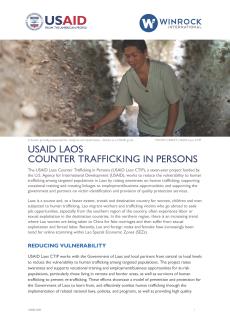The USAID Laos Counter Trafficking in Persons (USAID Laos CTIP), a seven-year project funded by the U.S. Agency for International Development (USAID), works to reduce the vulnerability to human trafficking among targeted populations in Laos by raising awareness on human trafficking; supporting vocational training and creating linkages to employment/business opportunities; and supporting the government and partners on victim identification and provision of quality protection services.
Laos is a source and, to a lesser extent, transit and destination country for women, children and men subjected to human trafficking. Lao migrant workers and trafficking victims who go abroad to seek job opportunities, especially from the southern region of the country, often experience labor or sexual exploitation in the destination countries. In the northern region, there is an increasing trend where Lao women are being taken to China for fake marriages and then suffer from sexual exploitation and forced labor. Recently, Lao and foreign males and females have increasingly been lured for online scamming within Lao Special Economic Zones (SEZs).
REDUCING VULNERABILITY
USAID Laos CTIP works with the Government of Laos and local partners from central to local levels to reduce the vulnerability to human trafficking among targeted populations. The project raises awareness and supports vocational training and employment/business opportunities for at-risk populations, particularly those living in remote and border areas, as well as survivors of human trafficking to prevent re-trafficking. These efforts showcase a model of prevention and protection for the Government of Laos to learn from, and effectively combat human trafficking through the implementation of related national laws, policies, and programs, as well as providing high quality support services to trafficked persons. USAID Laos CTIP complements the Government of Laos’ ongoing initiatives to respond to human trafficking. The project has been implemented in six provinces including; Vientiane Capital, Savannakhet, Salavan, Champasak, Oudomxay, and Luang Namtha, but the implementation in the first four provinces was completed in early 2024.
KEY RESULTS
- Enhanced knowledge among local TIP front liners and youth groups: Over one thousand members, with 25% were women of the Child Protection Network (CPN), which is comprised of village authorities, teachers, law enforcement officers, and youth representatives were trained to identify risks and methods of trafficking and exploitation in order to detect trafficking incidents and provide preventative measures in their communities.
- Enhanced coordination between the government and non-government stakeholders: In collaboration with the National Secretariat and Anti-trafficking Department, the project convened a series of multi-stakeholder consultations on the Laos National Plan of Action on Anti-Human Trafficking (2021-2025) as well as the subsequent training workshop for development of the sub–National Plan of Action. The meetings enabled both government and non-government representatives to share a vision and mutually understand each other’s roles and joint efforts to combat trafficking in persons in Laos.
- Assisted TIP victims, returned labor migrants and other vulnerable individuals, especially those impacted by COVID-19 to gain economic means: Almost one thousand people-at-risk and TIP victims (566 female) received livelihood and/or vocational training for economic empowerment.
- Engaged with over 150 private sector partners, mostly small and micro level shops and companies at the provincial level, for vocational training and internships. The project shifted its direction from working with large private sector companies to small shops/companies during and post COVID-19 pandemic to adapt to the operating environment of the private sector and the needs of the participants. This shift worked well to enhance the close partnerships with the private sector post COVID-19.
- Enhanced knowledge about CTIP among a wide variety of stakeholders: The project in collaboration with the Ministry of Information, Culture and Tourism (MICT) developed innovative Information Education and Communications (IEC) materials such as posters and cartoon animation; conducted workshops on prevention of child and sex tourism and trafficking for tourism industry and private sector; and disseminated IEC materials to the public in 36 common access points such as transport hubs (airport, bus station), border checkpoints, and schools. All these dissemination campaigns and workshops enhanced the understanding of the public, tourism stakeholders, and the government officers on TIP.
- Enhanced knowledge of over 280 government protection service providers and shelter caregivers on victim identification and psycho-social support to the survivors of human trafficking to better respond to the TIP cases and provide trauma-informed support.
- Conducted more than 10 public awareness raising campaigns on TIP and gender-based violence including social media awareness campaigns for the 16 Days of Activism against gender-based violence, Labor Day, and TIP Day - engaging prominent Lao social media influencers and celebrities turned out to be highly effective to reach out to the public, particularly youth groups.


